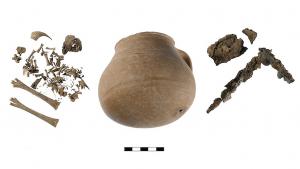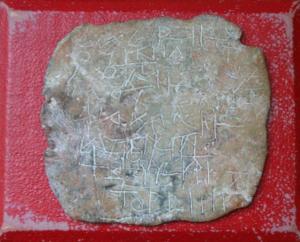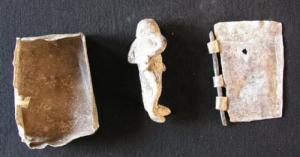The ancient Athenians practiced binding magick as shown by a 2300 year old curse jar and 2500 year old curse tablets, all discovered fairly recently.
Curse Jar

Inside the curse jar, archaeologists found iron nail, coin and bones of a chicken
[Credit: Athenian Agora Excavations]
Jessica Lamont, a professor of Classics at Yale University, wrote an article published in the American School of Classical Studies in Athens’ journal Hesperia 90 (2021), The Curious Case of the Cursed Chicken: A New Binding Ritual from the Athenian Agora:
“Excavations in the Athenian Agora recovered a ceramic pot buried in the back corner of an industrial and commercial building; the exterior of the vessel was inscribed with over 30 names, many female and several new or previously unattested in Attica. The pot contained the dismembered head and lower limbs of a young chicken. The vessel was pierced with a large iron nail and buried with a coin beneath the floor of the Agora’s Classical Commercial Building sometime around 300 B.C. The ritual assemblage belongs to the realm of Athenian binding curses and aimed to ‘bind’ or inhibit the physical and cognitive faculties of the named individuals. This unique discovery offers new evidence for the practice of ‘magic’ in the heart of ancient Athens.”
“’Curse tablets’ or thin sheets of lead inscribed with curses against a certain person, are well-known in Greece. They are commonly found underneath the ground after being buried there many centuries ago by the person who wanted someone to be cursed.
But in a twist on this type of witchery, archaeologists recently discovered the pottery jar filled with chicken bones, along with a coin, underneath the floor of the Athens Agora’s Classical Commercial Building, which millennia ago was the site of craftsmen who plied their trades there. …
The archaeologists determined that the chicken that had been killed had been no older than seven months before it was slaughtered to be used as part of the ritual; they believe that the people who employed the magic may have wanted to transfer ‘the chick’s helplessness and inability to protect itself’ to those they cursed by writing their names on the outside of the jar, [Professor Jessica] Lamont stated.
She further explains that the head of the chicken, which had been twisted off, and its piercing, along its the lower legs, meant that the corresponding body parts in the 55 unfortunate people would also be similarly affected.
‘By twisting off and piercing the head and lower legs of the chicken, the curse sought to incapacitate the use of those same body parts in their victims,’ Lamont notes.
She goes on to state ‘The ritual assemblage belongs to the realm of Athenian binding curses, and aimed to ‘bind’ or inhibit the physical and cognitive faculties of the named individuals.’ The pottery vessel was discovered near several burned pyres that still contained the burned remains of animal — another aspect of the curse, according to Lamont, which may have been something believed to have increased the power of the curse.”
Curse Tablets
On June 6, 2021, the Greek Reporter ran an article, Archaeologists Discover Ancient Curse Tablets in Athens Well:
“A major, and a bit spine-tingling, archaeological discovery of a trove of ancient curse tablets was made recently in Athens‘ downtown neighborhood of Kerameikos (Ceramicus) by archaeologists from the German Archaeological Institute of Athens.
A total of thirty well-preserved curse tablets dating back to the Classical period (2,500 years ago) were found in an ancient well which was originally discovered back in 2016, when other everyday objects — but not the tablets — were found.

Curse tablet.
[Photo credit: Dr. Jutta Stroszeck – German Archaeological Institute]
The ancient tablets have curses engraved on them which Athenian citizens would pay to have made against other people, a practice which was relatively common in ancient Greece. …
The curse tablets were found accidentally in 2020, while archaeologists were investigating the supply of water to a 1st century BC bathhouse which was close to the well.
Ancient Greeks were known to use the method of engraving curse tablets and attaching them to wells or tombs in order to curse someone with whom they had serious differences. …
They would place the tablets near tombs because they believed that the souls of the dead would carry these curses to the gods of the underworld. …
Normally, people would curse someone they hated for personal reasons, or perhaps someone who they were fighting in court.
Athletes also tended to engage in this unique practice, apparently in an attempt to bring bad luck upon their opponents.
Even ordinary merchants were known to curse the owners of rival businesses, in an effort to bring good luck to their stores and bad luck to those of the others.”

Lead objects found at the bottom of the Kerameikos well, dating back to the 5th century BC.
[Photo credit: Dr. Jutta Stroszeck – German Archaeological Institute]
Overview of Greek Magick
“The roots of magick stretch back to prehistory. Knowledge of what was termed superstition, but is now termed folklore, has shown that magick and the occult were a part of everyday life in ancient Greece. Virtually everyone believed in magick and practiced it, and periods of discrimination against magicians (and philosophers) were mainly politically motivated. Literary evidence shows that magick was practiced from the time of Homer until the Hellenistic period, during which time it underwent a resurgence. Various academics have proposed different theories to distinguish between magick and religion, but currently a number of scholars are suggesting that there is no fundamental difference. While there is no universal consensus as to how magick should be defined, one plausible suggestion is to define it as the imposition of the human will on nature or on other humans, using powers within the soul and permeating the universe. …
The so-called curse tablets … are normally thought of as having been written during the period from the fifth century BCE to the fifth century CE in an area spanning northern Africa and Europe. The earliest curse tablets were very simple and were found in Sicily and Attica from the fifth to the fourth centuries BCE. It has been argued that the earliest Sicilian binding spells could actually be dated from the late sixth century or early fifth century BCE. While the earliest curse tablets appear to have been limited geographically to Sicily, Olbia, and Attica in the fifth century BCE, they were all over the Graeco-Roman world by the second century CE. …
Quite often, ancient sources claim that those who practiced magick were either foreigners or women, or both. This could be referred to as cultural distancing where unacceptable attributes were projected onto other races or onto the opposite gender. The reality was that many Greek males practiced magick. The presence of large numbers of curse tablets and papyri are physical proof of just how widespread involvement in magick was for the Greeks. Magick was a part of daily life for the Greeks and was consequently thought of as mundane and unremarkable. …
… the practice of malevolent magick in Athens was quite prevalent, as indicated by philosophers’ criticisms, parodies in other writings, and actual curse tablets …
Magick to the ancient Greeks was often indistinguishable from their officially sanctioned cult practices, which in turn could be referred to as their religion. Expressing this more fully, magickal beliefs and practices were a part of everyday life, religious beliefs and practices were for the most part identical with forms of magick, and the neat distinctions used by contemporary academics between approved and disapproved forms of religion did not exist in antiquity except among a few philosophers.”
[Mierzwicki, Hellenismos, 149-51, 155-56, 160-61]
The primary reference text for this article is:
Tony Mierzwicki, Hellenismos: Practicing Greek Polytheism Today
Tony Mierzwicki
Author of Hellenismos: Practicing Greek Polytheism Today and Graeco-Egyptian Magick: Everyday Empowerment.
















